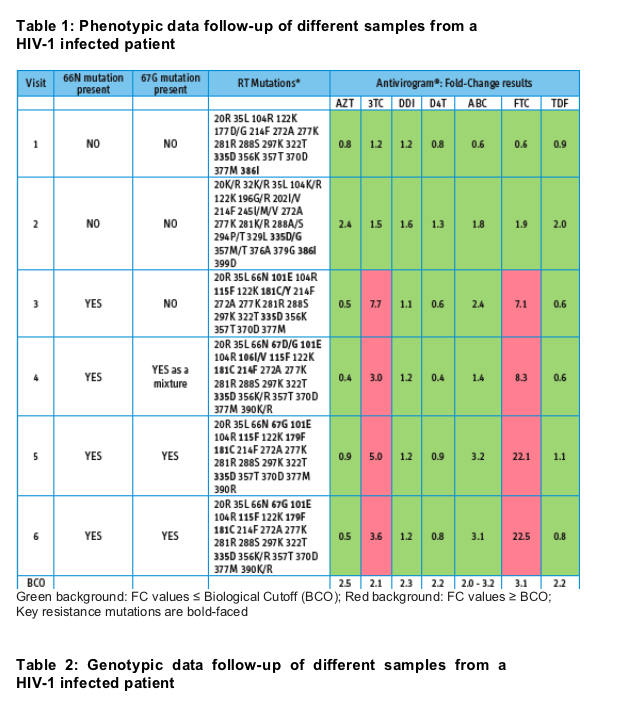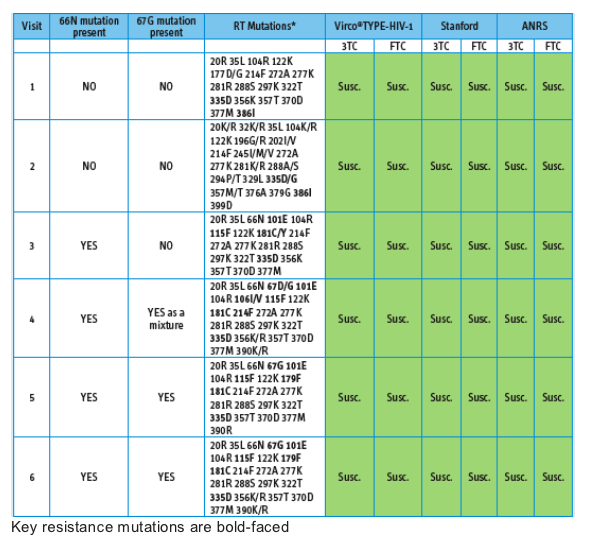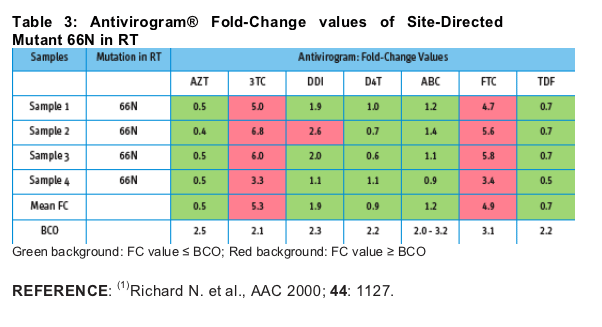| |
Reduced susceptibility to lamivudine and emtricitabine associated with the novel K66N mutation in HIV-1 reverse transcriptase
|
| |
| |
Reported by Jules Levin
HIV9, 9th International Congress on Drug Therapy in HIV Infection, 9-13 November 2008, Glasgow, UK
Y Verlinden, G Muyldermans, M Van Houte, K Van der Borght, L Rimsky* and T Pattery
Virco BVBA, Mechelen, Belgium; *Tibotec BVBA, Mechelen, Belgium
AUTOR CONCLUSIONS
The drug resistance profile of K66N, a novel mutation in HIV-• 1 reverse transcriptase (RT HIV-1 reverse transcriptase (RT), is identified as a result of discrepant phenotype/genotype results.
The rare mutation K66N in HIV-1 RT is associated with reduced phenotypic susceptibility to 3TC and FTC and not to the other NRTIs.
Further research is required to investigate the clinical impact of this finding, how the mutation evolves and whether it is selected during a specific therapy.
INTRODUCTION
Discrepancies between results obtained in phenotypic drug resistance tests and genotype or phenotype interpretation algorithms often lead to the recognition of important resistance-associated mutations.
Unexplained therapy failures can lead to the discovery of new mutations that are associated to HIV resistance.•
Here we describe the identification of the drug resistance profile of K66N, a novel mutation in HIV-1 reverse transcriptase (RT) conferring reduced susceptibility to the nucleoside RT inhibitors (NRTI) lamivudine (3TC) and emtricitabine (FTC), that was identified as a result of discrepant phenotype/genotype results.
METHODS
3TC and FTC for a patient failing his antiretroviral treatment.
The Virco Geno database was searched for isolates harbouring K66N.
A HIV-1 HXB2 site-directed mutant (SDM) harbouring K66N in the
RESULTS
A. Genotypic/phenotypic data follow-up of a patient failing his antiretroviral treatment
The genotypic/phenotypic data of different plasma samples taken during therapy from a patient failing his antiretroviral treatment are shown in table 1 and table 2.
During therapy, reduced susceptibility for 3TC and FTC was observed in the phenotypic assay (Antivirogram) from visit 3 onwards, while the genotype interpretation algorithms (VircoTYPE-HIV-1, Virco; Stanford; ANRS) showed a susceptible profile for 3TC and FTC for all visits.
Genotypic analysis of the different plasma samples showed the introduction of a 66N • and 67G(1) mutation in RT, which can lead to reduced susceptibility for 3TC and FTC.
One visit (visit 3) showed reduced susceptibility for 3TC and FTC although the 67G mutation was not present in the tested virus population.


B. Occurrence of K66N
K66N was a very rare mutation occurring in 0.026% of queried sequences of isolates present in the Virco Geno database (77/292,910).
44% of all K66N isolates found in the database harboured the mutation as a mixture • with the wild-type amino acid (34/77).
52• % of all isolates with K66N had a pure K66N mutation (40/77).
In 16% of all K66N isolates (12/77), the K66N mutation was found in combination with the M184V, indicating that the emergence of this mutation may be associated with exposure to 3TC or FTC.
C. In vitro phenotyping of a HIV-1 HXB2 SDM harbouring K66N in RT
Fold-change (FC) values obtained in the phenotypic assay (Antivirogram ) of a SDM harbouring K66N are shown in Table 3.
The FC values of SDM K66N in the phenotypic assay are above the BCO for 3TC and FTC. The mean of 4 measurements was 5.3 and 4.9 for 3TC and FTC, respectively.

|
|
| |
| |
|
|
|